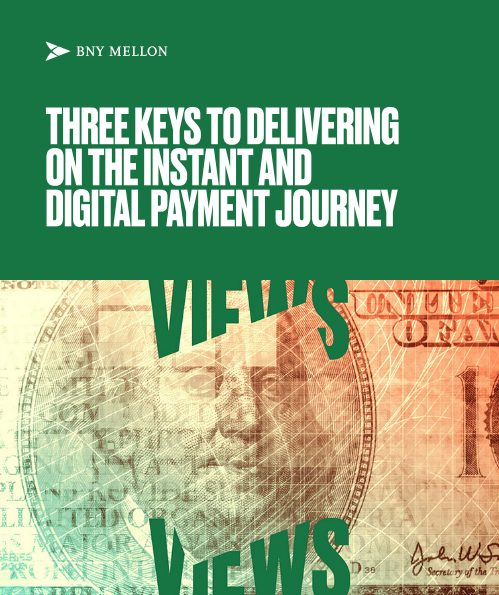
THREE KEYS TO DELIVERING ON THE INSTANT AND DIGITAL PAYMENT JOURNEY
As the demand for instant and digital payments increases, how can banks deliver for their clients? Andrew Haskell, product executive, Global FX Solutions, and Eralda Hasani, head of Immediate Payments and Disbursements, explore three key considerations for optimizing the transition to a digitized payments journey as the industry sets out to answer this question.

DOWNLOAD ARTICLE AS PDF
Unlock the potential of digital payments as demand skyrockets. Gain insights into innovative payment strategies for business growth with BNY Mellon.
The needs of all types of organizations – including banks, corporates, non-bank financial institutions (NBFIs) and fintechs – are evolving. As each embarks on their own digitalization journey, they face unique challenges to keep pace with the innovative capabilities that are emerging across the financial services space. There is, however, one common thread when it comes to transforming their payments options: the ability to move money instantaneously, 24/7/365 and with full transparency – regardless of jurisdiction.
Unfortunately, there is no silver bullet for the transformation process. The payment space is evolving rapidly; regional advancements continue to proliferate and global efforts continue to gain momentum. In the United States, the Clearing House’s Real-Time Payments (RTP®) launch in 2017 gave financial institutions and credit unions the ability to clear and settle payments instantly, 24/7. Now, the Federal Reserve's second instant payment rail, the FedNow® Service, launched in 2023 increases the scalability of instant payments. On a global scale, the ISO 20022 migration has made significant headway by meeting and exceeding milestones set by the Financial Stability Board (FSB). The G20 was able to achieve one-hour processing of 89% of international payments vs. 75% benchmark initially set by FSB1. Amid this rate of change, the key to unlocking desired advancements – even those not yet readily available in the market – is to bring together the disparate efforts across the payments space to fully shape the future of payments.
We explore some of these efforts and where the industry is on the journey to a so-called payments utopia where frictionless money movement is the industry expectation.
1. ISO 20022 and the long road ahead for cross-border payments
As a collective industry, we have long shared the desire to improve cross-border payments by aiming for more efficiency, better transparency, faster speed and inclusivity. While there have been some successes – notably the launch and adoption of Swift GPI – enacting real change in these areas has proven to be slow and laborious.
The scale of the task ahead is best exemplified by the 19 building blocks referenced in the “G20 Roadmap for Enhancing Cross-border Payments: Priority actions for achieving the G20 targets”2, a report by the FSB, the Committee on Payments and Market Infrastructure (CPMI) and its partner organizations that was developed to engage participants across the public and private sectors.
The report outlines material changes to be made in the pursuit of improved cross-border payments and provides a blueprint for the industry to follow, focused on three key themes: payment system interoperability; legal, regulatory and supervisory frameworks and data exchange; and message standards. To achieve all of this would help catapult us towards the so-called payments utopia, but each aspect of this journey comes with its own, unique challenges.
Take the industry’s current move through the ISO 20022 migration which is set to make the data contained in payment messages richer and more structured than ever. In the cross-border payment space, this means a move away from message text (MT) messages, where address information is provided in limited and unformatted fields, to ISO messages, where each address component has its own individual, structured field – yielding consistency and supporting automation.
While this transition is relatively simple and straightforward in theory, the scale of change involved is proving to be daunting. Banks have the information, but don’t necessarily have it in the correct format and converting the information to the structured format takes time and a substantial amount of effort. Now consider that the banks need to repeat this effort – for their accounts, databases, interfaces and internal systems – potentially across millions of instances.
Considering this is just one small piece of the payment technology enhancements that need to be in place to meet the goals outlined in the report, it is clear the industry still has a long way to go before the path to achieving frictionless money movement is realized. If we want to reach a payments utopia, financial institutions need to collaborate and innovate to find solutions and share best practices.
2. The instant payments landscape: not all real-time payments are created equal
The development and launch of real-time payment networks and initiatives are being seen and felt around the world. The aim is clear: leverage new technologies to transition away from legacy methods towards faster digital payment solutions that can accelerate commerce and improve the transaction experience. Yet, while this underlying goal is broadly agreed upon by market participants, the execution as well as progress has differed from region to region.
Some regions have tried to ensure success through regulatory efforts. In Bahrain, for example, the Central Bank of Bahrain mandated that all banks have the capability to provide inward real-time account-to-account transfers, known as Fawri+ transactions. So far success based on consumer adoption as a result of this mandate is impressive, with a recent report by ACI Worldwide forecasting the country to have the highest level of real-time payment consumer adoption by 20273.
Elsewhere, and in lieu of regulatory drivers, market-led initiatives are forging a path forward, as evidenced in India. Seven years from the launch of India’s real-time payments system – known as United Payments Interface (UPI) – the service now boasts 260 million users – nearly a fifth of India’s population – and accounts for around 75% of retail transaction volumes4. The driving force behind the adoption and use of UPI has arguably been its intuitive, easy-to-use nature, which is not only leading the shift away from cash, but also supporting financial inclusion across the country. It means that today, India is responsible for approximately 46% of all real-time transactions worldwide5.
Payment developments in the U.S. are also developing organically through market-led initiatives, although the pace of change has not yet caught up with more mature
real-time payment markets. In fact, a significant portion of both payable and receivable activity is still made up by checks, which introduces a host of pain points – from higher costs to a heightened risk of fraud.
Significant milestones in the real-time payments adoption and enablement journey continue to gain momentum. Six years post-launch, the RTP® network now reaches over 370 banks6 and continues to steadily grow. However, while uptake has included some of the largest banks in the country, some 9,000 banks and credit unions have yet to adopt RTP but are anticipated to change following the FedNow® Service launch.
The new, complementary service is poised to expand real-time payment access to smaller banks, which, in combination with the existing strength of the RTP network, can help to accommodate a growing number of use cases – and ultimately begin to change the future of real-time payments in the U.S.
3. There is a need for further payments innovation and harmonization
The challenges involved in meeting the lofty aims of the roadmap, combined with the different regional initiatives, makes the dream of instant, 24/7/365, borderless payments an ambitious and daunting goal. But it is by no means impossible.
One challenge across the international landscape is that while there may be mandates to improve entire payment systems in specific regions or directives to improve elements of payments globally, there is no overarching body positioned to decree the implementation of all 19 building blocks outlined in the report. This makes them optional at best – with approaches to putting them in place globally inconsistent and fragmented. One bank might tackle the first building block, another might focus on the fifth, ultimately moving in different directions on the journey towards payments utopia.
While governments, central banks and network operator mandates can accelerate transformation in a more forceful manner, there are bright spots with progress being made voluntarily. Specifically, multiple regional efforts that have the promise to bring about organic harmonization.
Examples include Buna, a cross-border and multi-currency payment system founded by the Arab Monetary Fund (AMF) in 2018, which enables the instant delivery of low- to mid-value payments that are urgent or time-sensitive, and Nexus, in Southeast Asia, which provides a blueprint to connect multiple instant payment systems, among others. Schemes such as these are coming together in their respective regions to promote the standards and approaches outlined by the FSB’s and CPMI’s 19 building blocks and have the potential to scale internationally and interoperate with other similar innovations.
As rapid payments technology innovation continues to develop, shaping payment trends of the future, we cannot wait to be told or mandated to make the changes necessary to reach this payments utopia. Every industry player needs to drive action to become agents of change by participating in digital transition efforts where possible and start incorporating these learnings within our own respective regions and communities. As product champions and change agents, we can help play an instrumental role in shaping the future of payments.
1"Swift connects instant payment systems to bring round-the-clock processing across borders,” Swift, Nov. 30, 2023
2 “G20 Roadmap for Enhancing Cross-border Payments: Priority actions for achieving the G20 targets,” FSB, Feb. 23, 2023
3 “World’s Major Economies Playing Catch-Up as Widespread Adoption Drives Global Real-Time Payments Growth,” ACI Worldwide, Mar. 28, 2023
4 “UPI goes global: The past, present & future of India's payments platform,” Wionews, Sept. 1, 2023
5 “World’s Major Economies Playing Catch-Up as Widespread Adoption Drives Global Real-Time Payments Growth,” ACI Worldwide, Mar. 28, 2023
6 “RTP® Network Surpasses 1-Million Payments on a Single Day,” The Clearing House, Sept. 6, 2023






